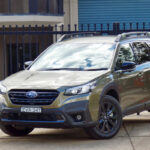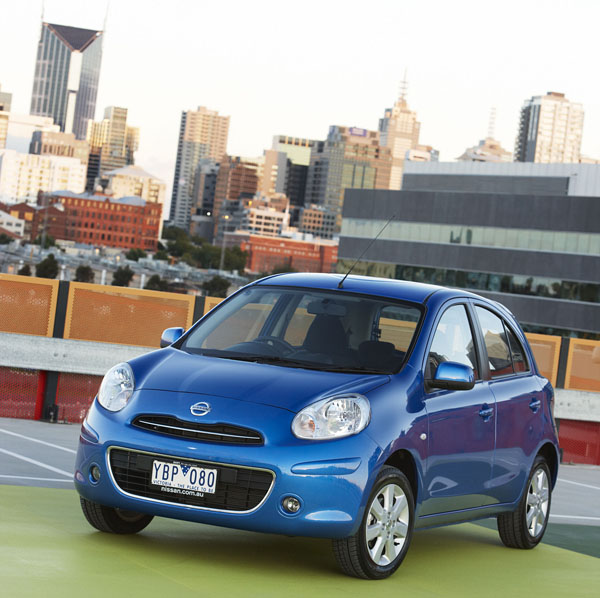Subaru Liberty is a no nonsense sedan or station wagon with a reputation for toughness and reliability. The Subaru Outback, launched in 1996 is based on the Liberty wagon and has increased suspension height, meaning it sits about midway between a conventional wagon and a 4WD. Outback is one of the earliest of the so-called crossover vehicles that have been increasingly popular over the last decade.
As more and more SUVs are really just 2WD vehicles with a taller body, Subaru Outback is standing out from the crowd.
In its first model the Outback had a tougher appearance than the Liberty wagon because of the protective plastic facings on the doors. These were discontinued with the new generation of 2003 to give the vehicle a more upmarket air. In this week’s feature we will look at this used-car feature, for no other reason than the original Outbacks are ageing and there can be a wide difference in their condition.
Subaru Liberty is sold as a four-door sedan and a five-door station wagon, with a much larger percentage of wagons being sold than in other models in its class. The combination of the traction of all-wheel drive and the practicality of a wagon rear end is a strong one with those who go to the snowfields or want to tow a midsize boat.
The engines have a flat ‘boxer’ layout, that is horizontally opposed (as in Porsche and old Volkswagen models) to lower the centre of gravity for improved road holding. This layout gives them the distinctive beat that many owners just love.
Engine capacities in the four-cylinder models are 2.0, 2.2 and 2.5 litres. The 2.0 actually has more performance than the 2.2 being a later design. Flat-six engines began with a 3.0-litre unit in the Outback, and later the Liberty range, its capacity increased to 3.6 litres in September 2009.Subaru calls the flat-six engines the H6 – ‘H’ for horizontally opposed.
These Subarus are reasonably easy to work on and most routine jobs can be carried out by an experienced home mechanic. However, safety items and most areas of the high-performance variants are best left to the professionals.
Spare parts prices are about average for a car in this class. The Subaru dealer network, though relatively small, works efficiently. Because of Subarus’ popularity in country areas there are dealers in comparatively remote areas.
There are a couple of high-performance Liberty variants. While these predate the 2003 starting point we have set for the rest of Liberty range we have included them because they are gaining some sort semi-rarity status and appeal to those who want to keep clear of the madding crowd.
The Liberty RS has a 2.0-litre turbocharged unit and was launched in Australia in 1992. It was on sale for less than two years, when it was upstaged by the smaller and lighter Subaru Impreza WRX. The Liberty B4 sports machine has a twin-turbo 2.0-litre. It first came here in August 2001 but the engine had been significantly detuned from the one offered on the Japanese market to run on our lower-octane petrol. The recently released Subaru Levorg can be likened to the RS and B4, but it’s far too new to be considered as a used car in this report.
Insurance charges are moderate on all but the high-performance Liberty RS and Liberty B4, which can be very expensive to cover. Even more so if you are a young and/or inexperienced driver.
WHAT TO LOOK FOR
Rust is not common in Subarus, but if one has been badly repaired after a crash it may get into the metal. Outbacks that played in the waters edge on a beach may also have problems.
Call in a professional inspector if there’s the slightest doubt about the body’s condition.
Have a look underneath an Outback, for signs of damage as some owners really do treat them as though they are ‘real’ 4WDs. The undersides of the bumpers, especially on their corners, are usually the first to suffer. With the sill panels a close second
Mud or a real buildup of dust may indicate a lot of time spent of the beaten track.
Look over the interior trim and carpets for signs of damage, though they usually hold up well.
Check out the luggage area for signs of harsh treatment caused by carrying big and/or sharp loads.
Be sure the engine starts quickly and immediately idles smoothly no matter how cold it is.
Manual gearboxes should be quiet in operation and gearchanges should be smooth and light. Automatics which tend to hunt up and down the gears, or which are slow to go into gear, could be due for an overhaul.
CAR BUYING TIP
When buying any family-oriented vehicle check the condition of the back seats and load area for higher than average wear rates. Also look at the bodywork immediately around the outside of the cargo area for scratches and dents.














